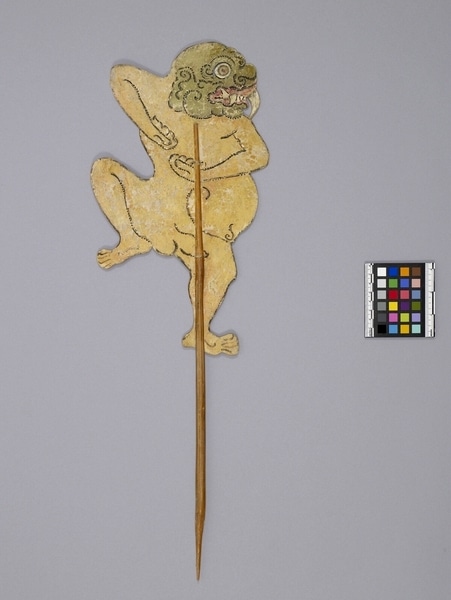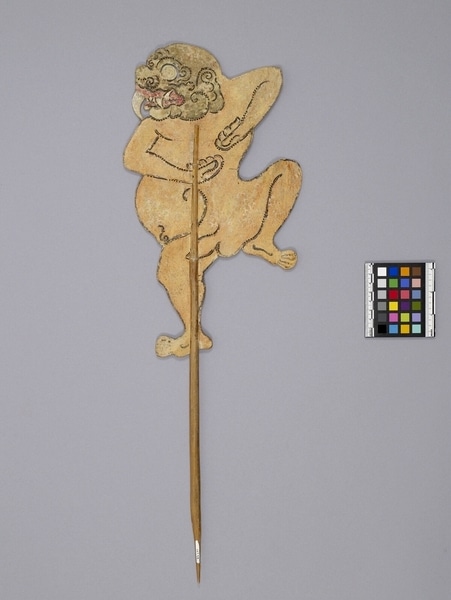Shadow Puppet Item Number: Ib271 from the MOA: University of British Columbia


Description
Humanoid shadow puppet figure with handle extending down from feet and split on either side, attached with string. Skin is perforated to hilight linear detail. Head in profile and body in three-quarter view, standing on one foot with other knee raised. Arms oriented with elbows out and hands held with fingers loosely curled, palms up in front of chest. Head is green, large, and round with upturned eyes. Tusks on top and bottom at outer corner of mouth; one large tusk at front. Mouth is red; tusks white, fleshy nose. Body is tan with black perforated lines marking legs, genitals, protruding stomach.
History Of Use
Javanese puppet theatre as an art form probably developed by the 11th century. The two-dimensional wooden wayang kulit puppets of Javanese religious shadow plays preceded the later and less sacred wayang golek puppets which appeared during the 16th century. Originally the plays depicted Javanese mythology, but after the Indian conquest of Java the Hindu epics, Ramayana and Mahabharata, were incorporated into the cycles, which comprise about 200 plays. The wayang kulit sacred shadow plays form is thought to have originated in southern India; the wayang golek puppets are indigenous adaptations. Although the prototype wayang kulit puppets are the older form, many symbolic elements remain the same. The shadow playss are performed by a dalang (puppet master) who is more formally a priest. An individual or requests a dalang to celebrate important occasions. The performances often last all night and are generally presented in three acts, with vocal and instrumental accompaniment. The individual plays vary widely in detail but usually involve conflict between good and evil. They serve a moral and religious purpose, and more recently, one of political commentary. Each puppet's character is represented by its appearance and placement onstage; protagonists with strong elements of good are placed to the right, antagonists of violent or evil nature to the left. Most plays are based on the Mahabharata cycle conflict between the Pandawa and Kurawa brothers, who each try to enlist the aid of the gods. However, in Javanese mythology, the evil ogres were introduced as a new group of antagonists. Tjakil and his companions now play fixed vital roles and appear whether or not they have a plot function. They are always hostile to the Pandawas; their purpose is to offer an example of unquestionable evil in the wayang purwa.
Iconographic Meaning
The tusks identify this figure as an ogre (raseka) or demon (buta). Figure exhibits other negative attributes: no clothing, round, upturned eyes (arrogance), green skin, widely separated legs, gross body. Buta and raskshasa are wild and variable with few established forms. Names depend upon the plays in which they appear and the dalang. Presence of one large tusk may indicate that this puppet is an aspect of Tjakil.
Cultural Context
Theatrical performance.
Item History
- Made in Java, Indonesia
- Owned by Tradewind Antiques before March 15, 1983
- Received from Museum of Anthropology Shop Volunteers (Funding source) and Tradewind Antiques (Seller) on March 15, 1983
What
Who
- Culture
- Javanese
- Previous Owner
- Tradewind Antiques
- Received from
- Museum of Anthropology Shop Volunteers (Funding source) and Tradewind Antiques (Seller)
Where
- Holding Institution
- MOA: University of British Columbia
- Made in
- Java, Indonesia
When
- Ownership Date
- before March 15, 1983
- Acquisition Date
- on March 15, 1983
Other
- Condition
- fair
- Accession Number
- 0886/0005